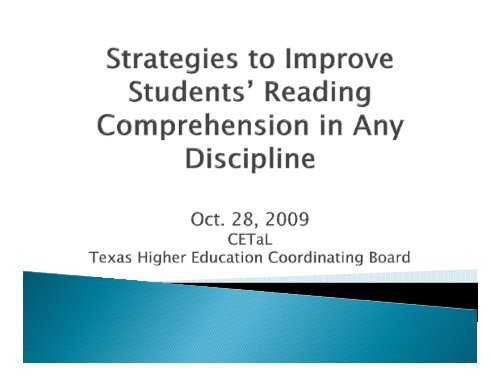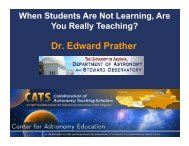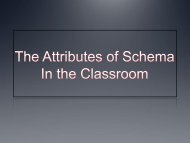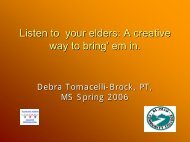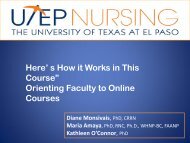Improving Student Reading Comprehension PPT ... - CETaL
Improving Student Reading Comprehension PPT ... - CETaL
Improving Student Reading Comprehension PPT ... - CETaL
You also want an ePaper? Increase the reach of your titles
YUMPU automatically turns print PDFs into web optimized ePapers that Google loves.
Nancy Shaffer: Developmental <strong>Reading</strong> andWriting Terri Storey-Gore: Developmental <strong>Reading</strong>and Writing Steven Varela: First-Year Composition
Purposes for readingand reading process Metacognition Previewing Main and supportingideas Annotating and notetaking Outlining and mapping Vocabulary Memory Study groups <strong>Reading</strong> Rhetorically Electronic texts Visuals TextbooksTexas Higher Education Coordinating Board
Current research at all levels l of schoolingemphasizes the importance of effectivereading comprehension, as well as thechallenges instructors face teaching it. At the university, though, we assume that thisis an ability that has already been acquired byour students, or that perhaps it’s not ourresponsibility to have to teach it.
How prepared are your students to read inyour classes? How do you know?
<strong>Student</strong> readiness for college-level reading hassteadily declined since 1999 to its lowest point intwelve years, and six million of the nation’ssecondary school students are reading well belowgrade level. Although studies have shown the need tocontinue developing reading skills and strategieslong after students are "able to read," 28 statesmandate teaching reading comprehension skillsthrough the eighth grade only— as thoughreading skills are fully developed by the age of13.
College-level reading preparedness is seldomaddressed in high school, particularly forstudents who are not identified by theirteachers as college bound. High schoolEnglish teachers assume students "know howto read" when they come to class. To a great degree—college professors havethe same assumptions and higherexpectations!
“This is boring.” “That was confusing… I didn’t get it.” “Stupid book.” “Why don’t they just tell us what we need toread for the test!”
“They didn’t even open their books.” “Are they even trying?!?” “How are they ever going to learn, if theydon’t read?” “It’s not my job to teach them how to read!”
What are some things you do to help studentscomprehend the readings in your classes?And, how do you know if they are working? OR What do you think you could do to helpstudents with reading comprehension in yourclasses? And, how would you determine ifthey are working?
We cannot change how well prepared p ourstudents are when they come to us, but wecan (teach) effective reading strategies in ourcourses regardless of the subject matter.Poor reading is a problem many of ourstudents face, so it is our problem, too.
Strategy #1: Pre-<strong>Reading</strong> for Focus Strategy #2: Distinguishing Main andSupporting Ideas
Look at theBOLD-FACED HEADINGSWhat tdo they tell us about tthePURPOSE of this reading?
SIZES / COLORS Identify their functions:TitleMain IdeasSupporting Ideas
WHY?HOW?WHAT?WHEN?WHO?WHERE?
TAKE NOTESWRITE SUMMARIES for each sectionOUTLINEDO CONCEPT MAPS
<strong>Student</strong>s often say: "How do they expect us to remembereverything from the reading when they assignover 30 pages to read?!?" "This is just too much. " "I bet they haven't read all of this themselves- I bet they haven t read all of this themselves-and they expect us to understand it all!"
One reason for this is because they have ahard time distinguishing main ideas fromsupporting details In other words, sometimes students "can't seethe forest for the trees" with the treesrepresenting the supporting details thatshould make the forest, or the main idea,clear.
Most college-level readings are structured tohelp students distinguish between main ideasand supporting details. Textbook chapters and sections within thechapter, as well as other types of readings weassign, all have one or more main idea or keyconcept. Authors then use explanations andsupporting ideas--including evidence andexamples--to clarify and support.
Showing students how to identify both statedand implied main ideas as well as how tounderstand the roles of supporting detailscan help them become more effectivereaders. Being able to distinguish between main ideasand supporting details helps students drawconclusions, evaluate, and critically interpretall integral skills for comprehension incollege reading.
These are basic questions you can ask both tostimulate interest in a reading and to create aframework for recognizing the main idea andsupporting details: Based on the title of the reading, what do you thinkthe article will be about? Is there one sentence that t describes the main ideafor this topic? What two words would you use to describe the"gist" of the paragraph? What details from the selection support this "gist"?
The headings in the textbook should serve asa guide to the overall pattern. They may vary in size, color, font type, orstyle (italicized, underlined, bolded, all capitalletters). Then, the paragraphs within those sectionsmight also follow a consistent pattern.
BOLD HEADING--ALL CAPSIntroduction to the concepts of this section orchapter.◦ Bold HeadingThe first concept will be considered in detail.
Pattern A: First sentence: Main idea Next sentence(s): Further explanation of the mainidea.Next sentence(s): Examples or evidence or both.Final sentence of the paragraph: May contain asummary idea of the main concepts of theparagraph, or a lead-in to the continueddevelopment of the main idea in the followingparagraph.
Pattern B: Paragraph starts with examples/evidenceand concludes with a main idea statement. Pattern C: Paragraph consists of examples andevidence as a follow-up o to the precedingparagraph's main idea statement. Pattern D: Paragraph provides explanations,examples, evidence, comparisons and contrasts,tbut the main idea is implied; it is not stated clearlyin any one sentence of the paragraph. This meansyou need to determine the main idea and write it inthe margin in your own words.
Teaching students to read these patterns willhelp them to identify the main idea andsupporting details. One simple strategy for this is to askstudents to highlight, underline, circle, orotherwise mark the main idea, explanations,examples, and evidence.
When students struggle to locate the main idea of aparagraph, they can use this process of elimination strategy.By identifying the supporting details first, they can narrowdown the paragraph's contents to arrive at the main idea.Identify the following--The three Es.◦ Examples◦ Evidence◦ ExplanationsHINT: Remind students to look for key words that signal examples, evidence, and othersupporting details in your specific textbook. Strengthening their awareness of signalwords such as "for example, as, like, imagine" may make a significant difference.If there is a sentence left, could it be the main idea? If so, itcould be the main idea.
If highlighting is taught, but not structured,students often over-highlight, hli h placing equalemphasis on many subordinate ideas and oftenmissing the main point. One solution is to Color Code annotation, usingdifferent colors for different kinds of ideas:BLUE- ExamplesGREEN- ExplanationsPINK-EvidenceRED- Main IdeasThis allows students to identify what kind of information isavailable quickly and to locate and study main ideas easily.
<strong>Student</strong>s will also experience the sameproblems with highlighting-if there is afocused strategy for pencil marking as well,students can differentiate between the levelsof ideas more clearly. BOX (around the sentence)=main idea SOLID UNDERLINE=explanation DASHED UNDERLINE=examples CIRCLE (around the sentence)= evidence
Although there are many other strategies,demonstrations, and sample exercises in theModules themselves, these are some of thequickest and easiest ones to implement right away. Once the modules are in the THECB repository, anyeducator can get a full look at what these moduleshave to offer and can modify these concepts to fittheir specific discipline.
Learners need to develop strategies that help themtake control of their learning. The purpose of our project is to create 14 digitizedinstructional modules designed to provide collegelevelfaculty with effective strategies to improvereading comprehension skills in entry-level l collegecourses across disciplines.
Thank you!!!!


